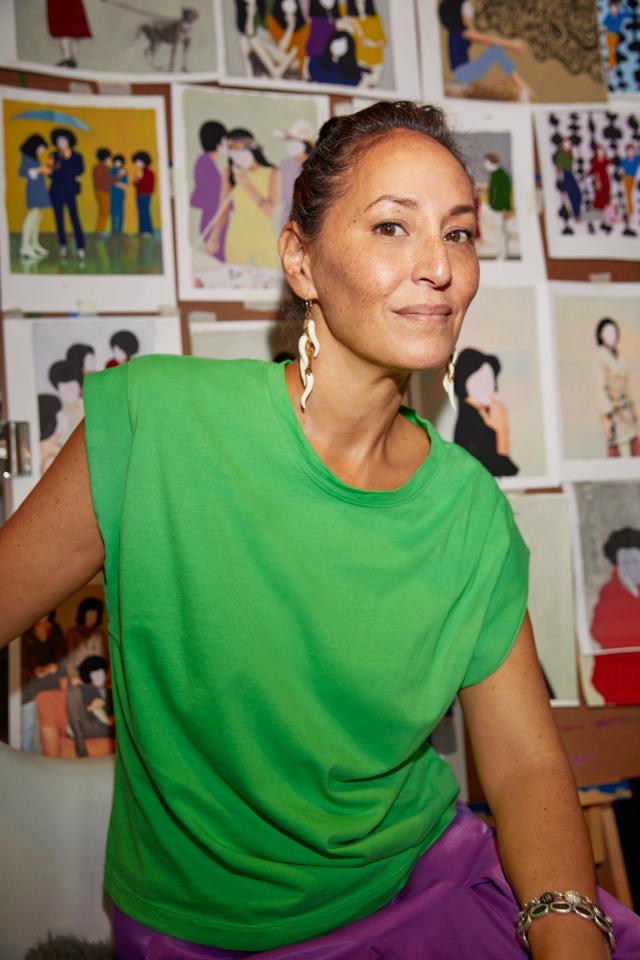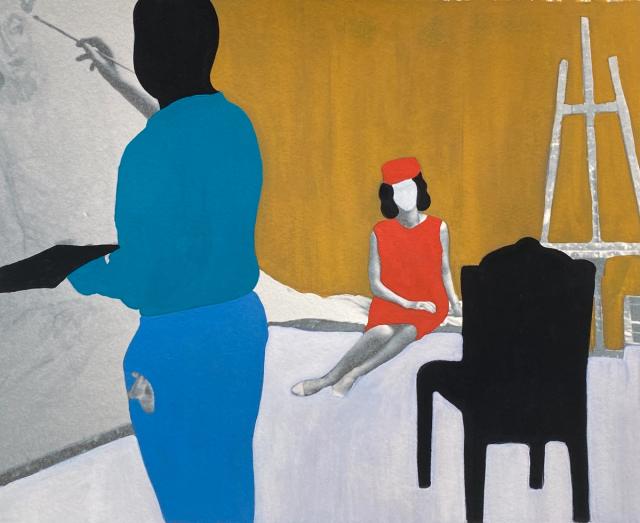

Describe your work
Bold
Graphic
Colorful

Erika’s Dress: My mother, a fashion designer, collaborated with another artist to craft this remarkable one-of-a-kind silk crotchet dress in the 1970s

During covid, I was inspired by my wall's blank canvas. The hallway was narrow, long, and uninteresting; painting it a color was an option, but it didn't feel that exciting. I toyed with the idea of wallpaper but could only purchase it online because nothing was open.
The shapes were part of a series I was working on, and I extended my canvas to my home and had so much fun doing it. Nothing was pre-planned. I freely pencil drew the forms and then painted. Sometimes a drop of paint landed where it was not supposed to, and I turned it into a new shape.
Who and what has influenced your work?
My family has influenced me enormously.
My parents were artists and fashion designers, and my home growing up was full of art, books, music and other creative people. Although I was born and raised in New York, my upbringing was very international. I went to the UN school from K-12 and was lucky to travel the world at a young age. My mother was from Japan, and my father was from Germany, so I was constantly exposed to multiple cultures. Dinner one night would be Japanese sukiyaki, and the next, it would be German schnitzel. The difference in how my parents were raised and then raised me impacted the style of my work. My perception of everything is what influences my work. From the abstract to the figurative, it has to do with how I look out into the world, digest it and create meaning that makes sense. For some people, this comes from words; for me, it is this conceptual visual relationship I have with everyone and everything I encounter.

Have you always been an artist?
Yes and no. I was always creative. As a kid, I would spend my time drawing, playing with clay, making dolls and clothes, or turning my family dining room into a house. When I was older, I would constantly redesign my bedroom by moving my furniture around, painting walls, or plastering it with magazine covers like wallpaper. I was big on repurposing clothing as well. My favorite top I made was from a canvas rice sack. My mom being Japanese would buy 10-pound bags of rice, so it was a perfect size. I was very skinny and could never find pants that fit my waist and were long enough, so I cut one pair to make extended cuffs for the other.
However, I never identified as an "artist" till I was in my 50s after my divorce. My father, who meant well, always told me a real artist could draw hands and feet, and I could not. So just being creative didn't mean I was an artist. I did not go to art school either. I even became a jewelry designer in my 40s, and it wasn't until I turned 50, when I started using a more traditional form of art, such as painting and collaging, that I began to say I was an artist. It was an outlet to process a very challenging time. Even now, if I do figurative paintings or drawings, the hands are in pockets or have no feet. I still suffer from some imposter syndrome because I came to it late.

Describe your creative process.
My process is dependent on the type of artwork I am creating. I initially began with mixed media and collage because I love to play with texture. I have also explored different types of textiles and made rugs from my designs. More recently, I have been working with a combination of photography and painting on paper.
I like to play around before I begin to work on a piece. When painting on photographic images, I do small renderings first to explore color, mediums, and how they affect the paper or image. I must have an abundant supply of materials in my studio because I like to play around before I begin to work on a piece.

"I have to make many mistakes before I get into a flow. Making art is like working out a muscle."
It doesn't come easily if I haven't done it for a while. The more I putter, play, and experiment with it, the easier it becomes. I know when something is interesting... it is when I am not even conscious of what I am doing, it's like breathing or eating. It feels exciting, and I am energized. A significant part of that state is that I am not judging my work. I am allowing space to create, which takes on a life of its own. It becomes a part of me, my emotion, the story, or the thoughts I have in my head about it.

"I go back to the basics of when I was a child. It has to be fun and intuitive. Kids don't overthink when they make art. They gravitate to a medium, and they experiment and explore. That's my process."


Tell us about your latest series, UN-SEEN.
I have always been inspired by color, texture, and shapes; my earlier work reflects this. However, now it's more about people, and I use old photographs and think about our relationship to images and the narrative we are led to believe.
For my series UN-SEEN, I only used family photographs because I realized I didn't know many of the stories behind the photos, and my parents are dead, so I will never know. Painting over the details changed the narrative for myself and the viewer. People could make up their own stories.
I continue to work with old photographs, with the same concept of changing the narrative. I am playing around with adding texture to the work as well. It's a deconstruction, then a renovation.

Mom in Paris. Early 1960’s, Portrait
Your DREAM project?
My dream project would be to design a mural in a public space.
Or to make large-scale tapestries of my work.